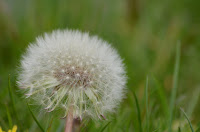Friday, May 18, 2012
Dandelion
What: Dandelion is one of my favorite flowers and edibles. It's one of the first to pop up and last herbaceous plants to send it's energy back to its roots for the winter. More often than not in any given area you can find the plant in all four stages of its reproductive life during the whole growing season (with flower buds, flowers, pollinated flowers, and seeds - or achenes - sticking out from the "receptacle").
In the photo on the top left, the early and abundant flowers are providing some of the first food for a pair of house flies (Musca domestica). Dandelions are in the Aster family and have what's called composite flowers meaning that the big round yellow guy sticking up (called a calathidium) is actually closer to a 100 mini flowers (called florets) than one flower (similar to how coral or the Portugese man o' war are not individual organisms but a collection of organisms that resemble and function as a single organism).
I didn't find a good source on the anatomy of a dandelion flower, so I thought I'd offer one here. In the bottom left photo of the dandelion in cross-section you can see the bracts - the little greenish purple guys beneath the flowers, the receptacle - the u-shaped structure that holds the seeds and has sap oozing out of it, and ray flowers - which are bisexual flowers that are attached to the receptacle and give the flower head - or ligulate head - its appearance. If you look at the underside of the flower head, the outer most florets have a beautiful maroon coloration to them and look like the bracts. If you look closely, each "petal" is actually 5 fused petals (notice the teeth at their tips) and corresponds to an individual flower.
The white fluff are the pappus and will form the all to familiar white parasols that float the seeds up to 5 miles away. Just above this, the split curly structures are the pistils (female) and fused to this in a ring at the base of the pistils are the stamen. I got this all straightened out after conferring with Liz Thompson and Matt Kolan. The fat short stubs in the middle of the flower head are florets that have yet to open (and might not open at all). And that's it! If you're going to learn flowers, dandelions probably aren't the best place to start.
Ecological notes: Dandelion thrives in places with little nutrient availability. As such, it has deep taproots that can access scant minerals deeper down. It's leaves spread out generously (called a basal rosette) and lay flat both to block other plants from sprouting near it (which would siphon away nutrients) and to take full advantage of the sunlight. The biggest one I've seen was more than 2' across! They're perennial so they can sprout up early in the spring and get their basal rosette out before other things can germinate.
Where: Everywhere (but the photos were taken in my backyard and an access road adjacent to Centennial Woods).
Other notes: Because of how common this plant is, it has lots and lots of names. Dandelion - Taraxacum officinale - translates in to "Tooth of the lion" because of the large teeth on the leaves. The French call it pissenlit, or "piss in bed" because of its diuretic qualities (often used to purify the liver). The species epithet, officinale, is mideval-Latin and indicates that it was used medicinally (as with the specific epithet for jasmine, lavender, rosemary, comfrey, ginger, fennel, rhubarb, and speedwell).
Subscribe to:
Post Comments (Atom)

.JPG)
.JPG)



No comments:
Post a Comment